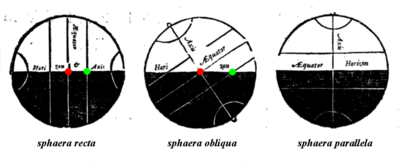Right ascension

Right ascension (abbreviated RA; symbol α) is the angular distance of a particular point measured eastward along the celestial equator from the Sun at the March equinox to the (hour circle of the) point in question above the Earth.[1] When paired with
An old term, right ascension (
Explanation

Right ascension is the celestial equivalent of terrestrial
As seen from Earth (except at the poles), objects noted to have 12h RA are longest visible (appear throughout the night) at the March equinox; those with 0h RA (apart from the sun) do so at the September equinox. On those dates at midnight, such objects will reach ("culminate" at) their highest point (their meridian). How high depends on their declination; if 0° declination (i.e. on the celestial equator) then at Earth's equator they are directly overhead (at zenith).
Any
Because right ascensions are measured in hours (of rotation of the Earth), they can be used to time the positions of objects in the sky. For example, if a star with RA = 1h 30m 00s is at its meridian, then a star with RA = 20h 00m 00s will be on the/at its meridian (at its apparent highest point) 18.5 sidereal hours later.
Sidereal hour angle, used in celestial navigation, is similar to right ascension but increases westward rather than eastward. Usually measured in degrees (°), it is the complement of right ascension with respect to 24h.[6] It is important not to confuse sidereal hour angle with the astronomical concept of hour angle, which measures the angular distance of an object westward from the local meridian.
Symbols and abbreviations
| Unit | Value | Symbol | Sexagesimal system | In radians |
|---|---|---|---|---|
| Hour | 1/24 circle | h | 15° | π/12 rad |
| Minute | 1/60 hour, 1/1440 circle | m | 1/4°, 15 ′ |
π/720 rad |
| Second | 1/60 minute, 1/3600 hour, 1/86400 circle | s | 1/240°, 1/4′, 15 ″ |
π/43200 rad |
Effects of precession
The Earth's axis traces a small circle (relative to its celestial equator) slowly westward about the
The currently used standard epoch is
History
This section needs additional citations for verification. (May 2012) |

The concept of right ascension has been known at least as far back as
With the invention of the

See also
- Celestial coordinate system
- Celestial pole
- Declination
- Ecliptic
- Equatorial coordinate system
- Equinoctial colure
- Geographic coordinate system
- Hour angle
- Right ascension of the ascending node (RAAN)
- Setting circles
- Sidereal time
Notes and references
- ISBN 0-935702-68-7.
- ^ Blaeu, Guilielmi (1668). Institutio Astronomica. Apud Johannem Blaeu. p. 65., "Ascensio recta Solis, stellæ, aut alterius cujusdam signi, est gradus æquatorus cum quo simul exoritur in sphæra recta"; roughly translated, "Right ascension of the Sun, stars, or any other sign, is the degree of the equator that rises together in a right sphere"
- ^ Lathrop, John (1821). A Compendious Treatise on the Use of Globes and Maps. Wells and Lilly and J.W. Burditt, Boston. pp. 29, 39.
- ^ Moulton, Forest Ray (1916). An Introduction to Astronomy. Macmillan Co., New York. pp. 125–126.
- ^ Moulton (1916), p. 126.
- ^ Explanatory Supplement (1992), p. 11.
- ^ Moulton (1916), pp. 92–95.
- ^ see, for instance, U.S. Naval Observatory Nautical Almanac Office; U.K. Hydrographic Office; H.M. Nautical Almanac Office (2008). "Time Scales and Coordinate Systems, 2010". The Astronomical Almanac for the Year 2010. U.S. Govt. Printing Office. p. B2.
- ^ Blaeu (1668), p. 40–41.
External links
- MEASURING THE SKY A Quick Guide to the Celestial Sphere James B. Kaler, University of Illinois
- Celestial Equatorial Coordinate System University of Nebraska-Lincoln
- Celestial Equatorial Coordinate Explorers University of Nebraska-Lincoln
- Merrifield, Michael. "(α,δ) – Right Ascension & Declination". Sixty Symbols. Brady Haran for the University of Nottingham.
- Sidereal pointer (Torquetum) – to determine RA/DEC.
